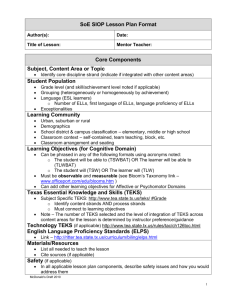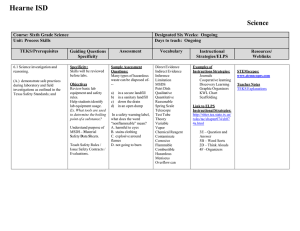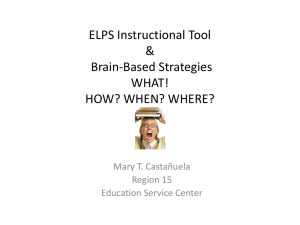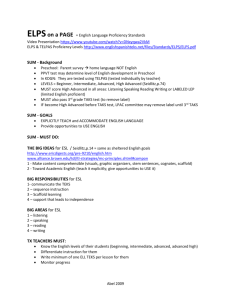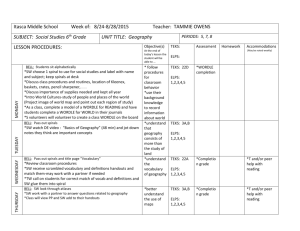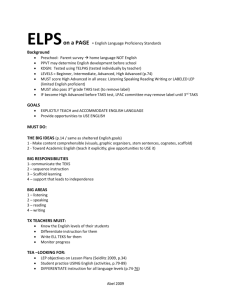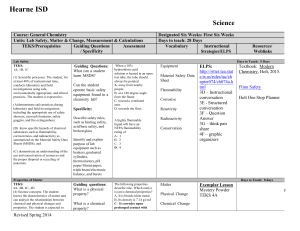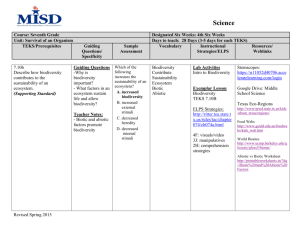5E Lesson Plan Guidelines
advertisement
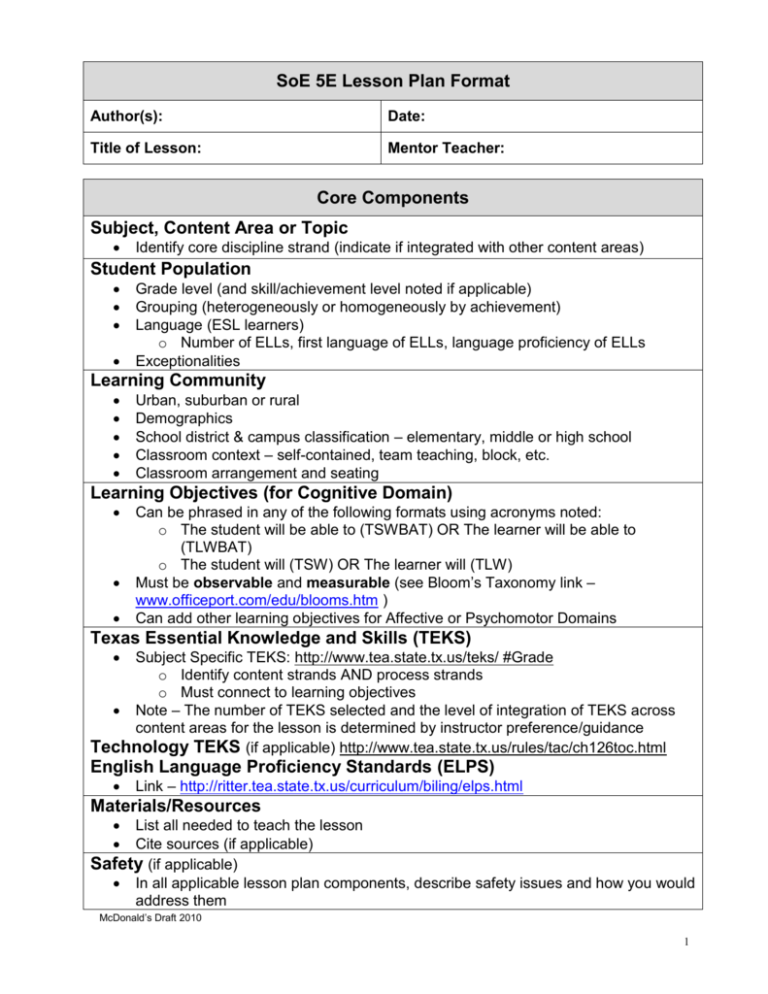
SoE 5E Lesson Plan Format Author(s): Date: Title of Lesson: Mentor Teacher: Core Components Subject, Content Area or Topic Identify core discipline strand (indicate if integrated with other content areas) Student Population Grade level (and skill/achievement level noted if applicable) Grouping (heterogeneously or homogeneously by achievement) Language (ESL learners) o Number of ELLs, first language of ELLs, language proficiency of ELLs Exceptionalities Learning Community Urban, suburban or rural Demographics School district & campus classification – elementary, middle or high school Classroom context – self-contained, team teaching, block, etc. Classroom arrangement and seating Learning Objectives (for Cognitive Domain) Can be phrased in any of the following formats using acronyms noted: o The student will be able to (TSWBAT) OR The learner will be able to (TLWBAT) o The student will (TSW) OR The learner will (TLW) Must be observable and measurable (see Bloom’s Taxonomy link – www.officeport.com/edu/blooms.htm ) Can add other learning objectives for Affective or Psychomotor Domains Texas Essential Knowledge and Skills (TEKS) Subject Specific TEKS: http://www.tea.state.tx.us/teks/ #Grade o Identify content strands AND process strands o Must connect to learning objectives Note – The number of TEKS selected and the level of integration of TEKS across content areas for the lesson is determined by instructor preference/guidance Technology TEKS (if applicable) http://www.tea.state.tx.us/rules/tac/ch126toc.html English Language Proficiency Standards (ELPS) Link – http://ritter.tea.state.tx.us/curriculum/biling/elps.html Materials/Resources List all needed to teach the lesson Cite sources (if applicable) Safety (if applicable) In all applicable lesson plan components, describe safety issues and how you would address them McDonald’s Draft 2010 1 SoE 5E Lesson Plan Process Components and Explanation Engage Description: Introductory lessons should stimulate curiosity and activate prior student knowledge. The activity should be a problem or an event that raises questions and motivates students to discover more about the concept. Link to cognition: Students bring knowledge about how the world works but it is sometimes based on limited experiences and sometimes on misconceptions. Guiding Questions: How will the teacher capture students’ interest? What kind of questions should the students ask themselves after the engagement? What teacher does: Create interest Generate curiosity Raise questions Elicit responses that uncover what students know or think about the concept/subject Address ELPS (as applicable) Explore Description: Students need the opportunity to actively explore the concept in a hands-on activity. This establishes a commonly shared classroom experience and allows students to share ideas about the concept. Link to cognition: Experiences occur before the explanations! Students are actively engaged with little explanation from the teachers. Students acquire a common set of concrete experiences allowing them to help each other understand the concept through social interaction. Guiding Questions: What hands-on/minds-on activities will students be doing? What are the “big idea” conceptual questions that the teacher will use to encourage and/or focus students’ exploration? Checking for understanding questions with expected responses What teacher does: McDonald’s Draft 2010 2 Encourage students to work together without direct instruction Observe and listen to students as they interact Ask probing questions to redirect students' investigations when necessary Provide time for students to puzzle through problems Act as a consultant for students Create a “need to know” setting Explain Description: Teachers use questioning strategies to lead students’ discussion of information discovered during the Explore stage (may or may not be a hands-on activity). Teachers introduce new scientific terms (vocabulary) and explanations at appropriate times during the discussion. Link to cognition: When students engage in meaningful discussions with other students and the teacher, they can pool their explanations based on observations, construct new understandings, and have a clear focus for additional learning. Guiding Questions: What questions or techniques will the teacher use to help students connect their exploration to the concept under examination? What are the higher order thinking questions which teachers will use to solicit student explanations and help them to justify their explanations? Checking for understanding questions with expected responses What teacher does: Encourage students to explain concepts and definitions in their own words Ask for justification (evidence) and clarification from students Formally provide definitions, explanations, and new labels Use students' previous experiences as the basis for explaining concepts Provide explicit instruction which facilitates students’ ELPS development (as applicable) Assess students’ growing understanding Elaborate/Extend Description: Students are encouraged to apply, extend, and enhance the new concept and related terms during interaction with the teacher and other students (in science, a hands-on activity). Link to cognition: Providing additional active learning opportunities for students to incorporate into their mental construct of the concept allows them to confirm and expand their understanding. Guiding Questions: McDonald’s Draft 2010 3 How will students develop a more sophisticated understanding of the concept? What vocabulary will be introduced and how will it connect to students’ observations? How is this knowledge applied in our daily lives? Checking for understanding questions with expected responses What teacher does: Expect students to use formal labels, definitions and explanations provided previously Encourage students to apply or extend concepts and skills in new situations Remind students of alternate explanations Refer students to existing data and evidence and ask "What do you already know?" "Why do you think.....?" (Strategies from Explore also apply here.) Provide activities that help students develop lesson’s ELPS (as applicable) Evaluate Description: Students demonstrate their understanding of the concept. Link to cognition: In learner-centered instruction, it is important for students to be aware of their own progress as an outcome of instruction. Students construct knowledge over time and may need additional experiences to refine their understanding of the concept. Guiding Questions: How will students demonstrate that they have achieved the lesson objective? How will evaluation be embedded throughout the lesson as well as at the end of the lesson? What teacher does: Observe students as they apply new concepts and skills Assess students' knowledge and/or skills Look for evidence that students have challenged their thinking or behaviors Allow students to assess their own learning and group process skills Ask open-ended questions, such as "Why do you think...? "What evidence do you have?" "What do you know about x?" "How would you explain x?" Assessment must correlate to the learning objectives and TEKS Assess ELPS (as applicable) For IMAX/Intern I and II Candidates Only: Intern Signature Mentor Teacher Signature Date McDonald’s Draft 2010 4 Management Issues 1) How long is the lesson expected to last? a. Under what conditions or possible reasons would the timing of instruction need to be modified? 2) Are classroom rules, procedures and consequences already established in this class? a. If so, list them here. If not, identify general rules, procedures and consequences that will be implemented. And, describe how the students will taught/trained/informed of the rules, procedures and consequences. 3) How will the needs of second language learners be addressed? 4) How will instruction be modified during the lesson for special needs students? 5) What technology resources will be used to teach the lesson? 6) What technology resources will be implemented for student use to master the learning objectives? 7) How will technology be integrated in the lesson? a. How will integration of technology be managed in this lesson (specifically, will there be different management needs for use of technology by the teacher or students?) 8) How will student comprehension of the learning objectives be verified? 9) What if students do not comprehend the learning objective(s)? What alternative instructional strategy can be implemented? 10) How will instructional effectiveness and/or if instruction is meeting the needs of ALL learners be verified? 11) How will students be called on to ensure optimum participation of ALL students? 12) How will student attention be gained to begin a different aspect of the lesson and/or if they get off-task? a. What will be done if distractions occur? b. What attention getting strategies can be implemented if needed? 13) How will students be praised or provided incentives (not just extrinsic rewards, must include how student motivation will intrinsically be addressed)? a. What actions will students be praised for? 14) How will student misbehavior be corrected? a. Minor violations? Moderate violations? Major violations? 15) Are there social skills that must be taught or modeled for ensuring effective group work (do not assume that they know these)? a. If so, what are they and how will they be addressed? 16) How will students’ comprehension of directions and their ability to follow those directions be ensured (do not say, “I will ask them if they understand”…you must come up with a proactive way to ensure student comprehension)? 17) How will students be moved from one aspect of the lesson to another, especially if at different points they operate in groups and individually? 18) How will materials be distributed? a. When will they be distributed? 19) Where and how will students turn in their work? 20) What transitional activities will be implemented for this lesson? 21) What is planned for students who finish early? 22) What will be said if students ask why this content/concept is important to learn? McDonald’s Draft 2010 5 McDonald’s Draft 2010 6

